Red Knot - June 2003 Species of the Month
NOTE: Content on this page has not been updated since October 2004; please see Red Knot - An Imperiled Migratory Shorebird in New Jersey for the latest information on this species.
|
Survival of the migratory red knot depends on the
horseshoe crab. Every year in May, the horseshoe crab lays its eggs along
New Jersey's southern and central beaches. En route from the southern
tip of South America to their breeding grounds in the Canadian Arctic,
red knots stop on the beaches of the Delaware Bay to gorge on the fat-rich
crab eggs.
Studies show a significant decline in the spawning
horseshoe-crab population during the past decade and consequently, a lower
concentration of crab eggs, leaving many migrating shorebirds without
enough to eat. Unable to gain sufficient weight during their Delaware
Bay stop over, many shorebirds lack the energy to complete their Arctic
migration and to reproduce. Most in peril is the red knot, listed as a
threatened species in New Jersey in 1999. Scientists predict it could
be extinct within seven years.
|
 Red knots in Delaware Bay surf
Red knots in Delaware Bay surf
© Clay Walker |
|
This spring, both New Jersey and Delaware took significant
steps to protect the red knot population from further decline. Both states
imposed restrictions on horseshoe crab harvest and on public access to
Delaware Bay beaches to allow shorebirds to feed undisturbed.
Every year since 1999, DEP staff leads a team of experts
from the United States, Canada, Argentina and Chile to study the red knot's
various habits and habitats along its migratory path.
|
|
Gaining Weight for the
Trip
There is a dramatic difference
in appearance from when a red knot arrives on the Delaware Bayshore and
when it is ready to depart for the Arctic.
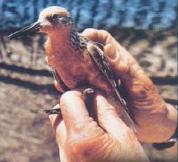
Red knot upon arrival
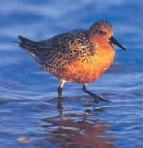
Red knot ready to depart
|
The Red Knot – Traveling
on the Edge
- The beaches in Delaware Bay are essential
spawning habitat for the world's largest concentration of horseshoe
crabs. In turn, these beaches attract the Western Hemisphere's
second-largest spring migration of shorebirds, which feed on
the crab eggs. Over a million shorebirds representing six different
species including red knots, feed on the eggs in May and early
June.
- Major declines
in the spawning horseshoe crab population since the early 1990s
and a lower concentration of crab eggs are attributed to an
increase in the numbers of crabs being harvested to satisfy
the growing public demand for conch and eels, trapped by using
horseshoe crabs as bait.
- The red knot is hardest hit by this decline
because about 90percent of its population in the Western Hemisphere
"refuels" on Delaware Bay each spring. DEP biologists
have discovered a decline in red knots on Delaware Bay, from
95,000 in 1989 to fewer than 32,000 in 2002. A decline of more
than 50 also was observerd at its South American wintering area.
The count for May 2003 was the lowest ever at just 16,000 knots.
- Red knots arrive in Delaware Bay from South
America thin and tired, many of them having flown non-stop for
four days. They must quickly double their weight to make the
long flight to the Canadian Arctic and to breed once they arrive
there. High energy crab eggs are essential. However, many red
knots are not reaching the threshold weight necessary to make
the trip and to breed. Additional conservation measures are
needed to improve numbers of horseshoe crabs and create refuges
where knots and other shorebirds can feed undisturbed.
|
|
Facts of Interest about the Red
Knot
- Must gain a minimum of 6 grams of weight
per day while in Delaware Bay, to complete its journey to the
Arctic and to breed. Red knots gained weight at the rate of 8
grams per day in 1997; now they only gain at the rate of 2 grams
per day.
- Size of a dove with a distinctive breast
of rusty red during the summer breeding season; has a short, straight
black bill and long wings.
- Usually seen in Delaware Bay on sandy beaches
with gentle slopes and minimal wave action; often roost on long
sandy spits at ocean inlets, marsh islands, or the high portions
of sandy beaches
- In the Arctic, establishes nests in vast
areas of sparsely vegetated, low elevation tundra; and in wintering
areas they are found primarily on large tidal flats
- The red knot is recognized as a high priority
species in the National
Shorebird Conservation Plan, is on the Audubon
Watch List, and is a U.S. Fish
and Wildlife Service species of conservation significance.
|
|
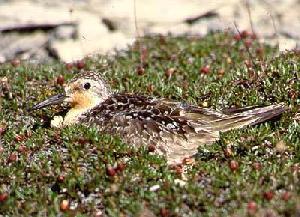
Red knot on Arctic nest
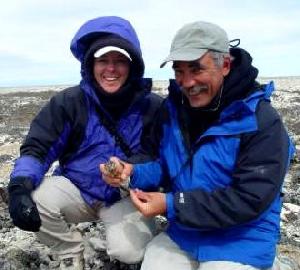
Biologists Amanda Dey and Larry Niles band
knot chicks in the Arctic
|
| Ways You Can Help |
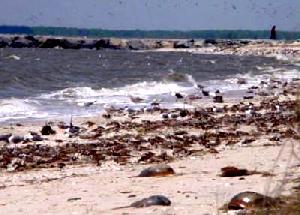
Shorebirds on Delaware Bay |
Don't walk on the beach during spring
when shorebirds are present, and keep dogs on a leash. Use designated
viewing areas for watching shorebirds, and study them from a distance
with binoculars or a spotting scope. To learn more about suggested shorebird
viewing areas, review the map in the following brochure: Imperiled Shorebirds on the Delaware Bay - What You Can Do to Help. (pdf, 423kb)
While many Delaware Bay beaches and some
Atlantic coastal beaches are known to support horseshoe crab spawning
from year to year, the DEP's Division of Fish and Wildlife is asking citizens
to share their information and observations of current spawning sites.
To learn more about observing horseshoe crab spawning and how to report
such information, please read the following article on the DEP's Division
of Fish and Wildlife Web site: Help
Identify Horseshoe Crab Spawning Habitat.
|
| Additional
Sources of Information |
|
|
|